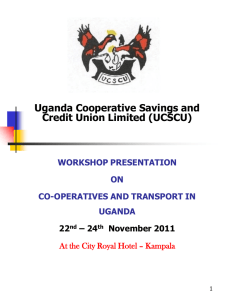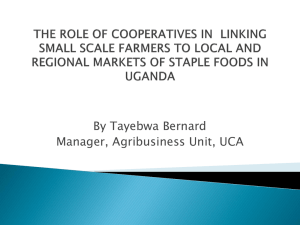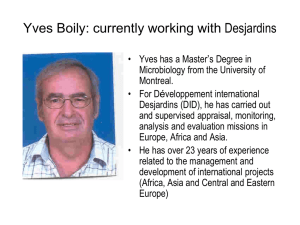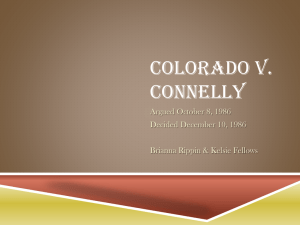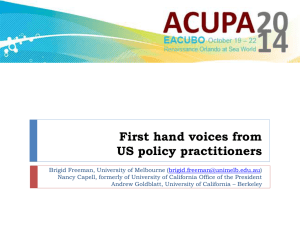Fourteen- seater Transport SACCOs - The Co
advertisement
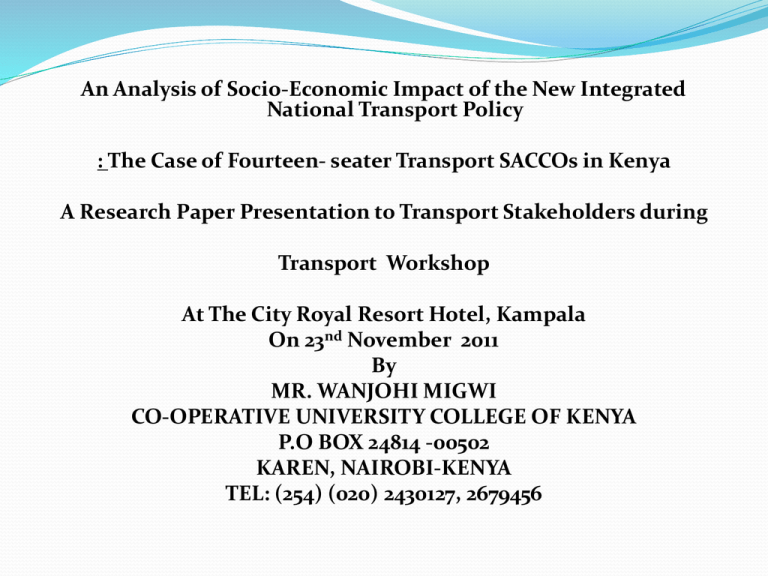
An Analysis of Socio-Economic Impact of the New Integrated National Transport Policy : The Case of Fourteen- seater Transport SACCOs in Kenya A Research Paper Presentation to Transport Stakeholders during Transport Workshop At The City Royal Resort Hotel, Kampala On 23nd November 2011 By MR. WANJOHI MIGWI CO-OPERATIVE UNIVERSITY COLLEGE OF KENYA P.O BOX 24814 -00502 KAREN, NAIROBI-KENYA TEL: (254) (020) 2430127, 2679456 A 14 –seater matatu 1.1 Background to the study Paratransit, going by the name “matatus” in Kenya, form the main public transport in Kenya, estimated to control 80% of the public transport. A “matatu” is a public service vehicle (PSV) having a seating capacity of not more than 25 passengers (The Traffic Act Cap403 (1963)). Background cont… “Matatus” play a very important role in the social- economic development of a country as they provide incomes to the owners, informal and formal employees, insurance companies, associated businesses and taxes to the Central and Local governments. Directly and indirectly, the “matatu” industry provides 80,000 and 80,000 jobs respectively..This implies that the fourteen seater “matatus” provide directly and indirectly 56,000 and 56,000 jobs respectively. The fourteen- seaters “matatus” are individually owned and managed. However, some owners are members of Savings and Credit Cooperative Societies (SACCOs) where they save and borrow money and access transport routes commonly controlled by the SACCOs. 1.2 Statement of the problem The “matatus” business in Kenya is controlled by The Traffic Act Cap 403(1993). However, most of the legal provisions of the Act were not complied with prior to 2003 due to bad governance, corruption and general disregard of the rule of law. The effect of this was increase in fatal accidents due to overloading, disregard of traffic regulations, poor vehicles’ maintenance, careless driving, lack of standards and stiff competition. This called for regulation of “matatu” industry through introduction of Legal Notice NO.161 of 2003 which gave birth to the Integrated National Transport Policy which aimed at efficient, affordable and safe transport services. The policy was unveiled for implementation in November 2010 According to the policy, among many measures, is a Statement of problem cont.. shift to higher capacity vehicles with explicit instruction of not licensing any new fourteen –seater vehicle for public transport with effect from 1st January2011 and those in operation are to operate and phased out through natural attrition. In addition to this, all operating “matatus” must join existing or form SACCOs or companies. This was followed by “mushrooming” of hurriedly registered PSVs SACCOs. Phasing out of the fourteen- seaters means phasing out of the SACCOs which do not have capacity to acquire high capacity vehicles. In response to the posing uncertainty of the 14-seaters PSVs SACCOs,astudy was commissioned by the college in March 2011. This study was to investigate the implications of the new transport policy on the survival of the fourteen –seaters transport SACCOs and employment levels in the SACCOs. It was also to propose actions to be taken by individual owners, SACCOs, Ministry of Cooperatives Development and Marketing and other stakeholders 1.3 Objectives of the study The study was to establish: 1. The number of the registered 14-seaters PSVs SACCOs in the country and in the main towns in the provinces. 2. The level of compliance with the new transport policy in term of transport SACCOs registration. 3. The level of membership and gender representation in the registered 14-seaters PSVs SACCOs in the main towns in the provinces 4. The strength of the registered 14-seaters PSVs SACCOs in the main towns in the provinces in terms of members’ capital and loan to members. Objectives cont… 5. The strength of the registered 14-seater PSVs SACCOs in the main towns in the provinces in terms of members’ capital and loan to members. 6. The strength of the registered 14-seater PSVs SACCOs in terms of routes and vehicles they managed. 7. The level of employment in the registered 14-seater PSVs SACCOs in the main towns in the provinces 8. The business plans in place to be able to comply with the new transport policy. 9. The level of awareness of the new transport policy implications to the 14-seater PSVs SACCOs and members in the main towns in the provinces 10. The training gaps of the members and management board Research Questions 1. How many registered 14-seater PSVs SACCOs were there in the country and in the main towns? 2. How many 14-seater PSVs SACCOs had been registered since 1st January 2011 in the main towns? 3 .What was the level of membership and gender representation in the registered 14-seater PSVs SACCOs in the main towns? 4. What was the level of share capital and share capital contribution of the members in the registered 14-seater PSVs SACCOs in the main towns? 5. What was the level of loan to members in the registered 14-seater PSVs SACCOs in the main towns? Research Questions cont…. 6. How many employees were employed in the registered 14-seater PSVs SACCOs in the main towns? 7. What were the new policy implications on the registered 14-seater PSVs SACCOs? 8. What was the qualification and experience of the board members in the registered 14-seater PSVs SACCOs in the main towns? 9. Had pre-cooperative education been offered to board members of the registered 14- seater PSVs SACCOs in the main towns in the provinces? 10. What business strategy was in place to comply with the new transport policy? Research Questions 1.4 Research Questions 1. How many registered 14-seater PSVs SACCOs were there in the country and in the main towns? 2. How many 14-seater PSVs SACCOs had been registered since 1st January 2011 in the main towns? 3 .What was the level of membership and gender representation in the registered 14-seater PSVs SACCOs in the main towns? 4. What was the level of share capital and share capital contribution of the members in the registered 14-seater PSVs SACCOs in the main towns? 5. What was the level of loan to members in the registered 14seater PSVs SACCOs in the main towns? 1.5 Methodology The investigation was carried out through descriptive survey and random and purposeful sampling was used. Secondary and primary data were collected during the end of the month of June 2011 through two open –ended questionnaires targeting DCOs and SACCOs as respondents. The primary data was collected from 78 SACCOs and 15 DCOs in the main towns – Nairobi,Thika,Muranga,Nyahururu,Nyeri,Nakuru,Kericho,Eldoret, Kisumu,Kakamega,Embu,Meru,Kitui, Machakos and Mombasa) of the seven provinces in Kenya and analyzed through Statistical Packages for Social Sciences while findings were presented using charts, graph and percentages. Methodology cont.. A validation workshop was held at the college on 15th-16th August 2011.The workshop was attended by mainly the board members of the low capacity (fourteen –seater) and a few board members of high capacity PSV SACCOs from whom the data was collected .In attendance were also the stakeholders in the co-operative movement, media and transport industry such as CIC, Co-operative Bank of Kenya, KUSCCO, Transport licensing Board and officials from the ministry of MoCDM. The purpose of the workshop was to validate the finding Summary of findings 1 In the seven provinces, majority of the SACCOs were registered in 2010 and 2011 as shown by the increased number of SACCOs registered. 2 On the number of board members in the SACCOs, it was found that majority of the SACCOs had six to twelve board members while a few had four to six members . It was also established that women were not adequately represented in the board as in some of the SACCOs, there were very few or no women, which is contrary to the mandatory rule of one third representation of women in all public offices. The membership in the SACCOs was low as majority had slightly above twenty members while a few had fifteen to twenty. 3 4 Findings continued… 5. It was also found that in majority of the SACCOs, there were very few or no women members. However, in a few of the SACCOs, the number of women was high. 6. Majority of the SACCOs were weak in terms of loan granted and capital base while a few were strong. For instance, some SACCOs had not granted any loans to members while a few had granted loans to the tune of millions in Kenya shillings. However, many SACCOs had experienced high monthly members’ share contributions while a few had experienced low monthly share contribution. . Summary of findings cont.. 7. Many SACCOs were managing very few PSVs and routes. 8. Many SACCOs had few employees employed to work in the offices as many had only one employee. However, a few had more than one employee while others did not have any. At the bus parks, many SACCOs had slightly more than one employee. 9. Majority of the SACCOs had chairmen of the board with one to two years experience in cooperative management while a few had none with any experience. Majority of the SACCOs had vice chairmen and treasurers with no cooperative management experience while a few had some with one to two years experience. 10. It was found out that majority of the SACCOs had board members with pre-cooperative education while a few had none. 11.Majority of the board members of the SACCOs were aware of the new transport policy and had sensitized the members. However, a few had board members who were not aware of the policy and had not sensitized the members Summary of findings cont.. 12. On average, SACCOs had business plans of moving to higher capacity vehicles while others did have any plan. 13. Majority of the SACCOs agreed that if the policy was implemented as it is, many SACCOS would wind up. However, a few disagreed with that assertion. 14. To comply, majority of the SACCOs wanted more education to be offered especially in the area of cooperative management while others wanted to be assisted with loans to enable them buy higher capacity vehicles. 15. It was found out that many SACCOs had invested elsewhere especially in shares, insurance agencies and in petrol stations. A few had not invested elsewhere hence, were only depending on the income from the 14seaters PSVs core business. Findings cont… 16.Lastly, it was found out that, a few SACCOs had few managers with form four, degree, diplomas and CPA certificates, while others had not employed the managers. Few SACCOs had accountants with qualifications such as CPA, while others had not employed any. Many SACCOs had no credit officers and those who had, the credit officers had form four certificates. Majority of the SACCOs had not employed other staff, while those who had, the staff had form four certificates. Conclusion. 1. More registration of the SACCOs in 2010/2011 does not shows an attitude change of the investors towards complying with the new transport policy that requires investors in the industry either join or form SACCOs or companies. 2.The number of board members within the SACCOs is within the threshold stipulated in the Cooperative Act Cap 490. Low women representation in the board may be attributed to the fact that there were few women investors in the industry because of many compliance requirements, harassment from police and “gangs”, stiff competition, high operational risks, high capital requirements and disorganized manner the players manage the business. 3.Low membership in the SACCOs may be attributed to many compliance requirements, harassment from police and “gangs”, stiff competition, high operational risks, high capital requirements and disorganized manner the players manage the business .These factors may have scared away both women and men investors. 4.Weak capital base and low loan granted to members in majority of the SACCOs may be attributed to the fact that majority of the SACCOs were newly registered hence low membership and capital contribution. Conclusion cont.. 5.High monthly members’ share contribution may be attributed to increasing need of fast capital formation to enable the members’ access loans from the SACCOs. 6.Low number of PSVs and routes managed by the SACCOs may be due to low membership due to low number of investors in the industry because of many compliance requirements, harassment from police and “gangs”, stiff competition, high operational risks, high capital requirements and disorganized manner the players manage the business. In addition to this, there is lack of need to expand the routes outside the region the SACCOs are based hence opening the business to stiff competition. 7.Low employment level in the offices may be attributed to the fact that majority of the SACCCOs were new with no functional offices. During data collection, it was observed that many SACCOs had “make-shift” offices at the bus parks simply for compliance sake. Some do not have furniture and records (ref: Kericho Town) 8.Many vice chairmen, treasurer and a few chairmen lacked experience in cooperative management. This may be attributed to the fact that majority of the SACCOs were recently registered and may not have attracted people with experience. Conclusion cont….. 9.A few SACCOs had not had pre-cooperative education. This may be attributed to the fact that many of these SACCOs were formed in a hurry to beat the registration deadline. 10.Although some SACCOs had business plans while others did not have, the business plans were not backed by financial ability as the SACCOs had weak capital base which could only attract very few financiers. This poses survival threat to the SACCOs as the new transport policy is fast beckoning. This means one by one the 14seaters PSVs may be put out of business through natural attrition, and with the common bond gone, the SACCOs may definitely collapse leaving traces of loss of employment for drivers, conductors and SACCOs staff in addition to high loss of income to the investors. 11.The fact that many SACCOs have invested in alternative businesses does not caution them from eminent collapse as their survival depends on the membership which depends on the common bond and with the common bond gone, members will automatically withdraw from the SACCOs 12.Lastly, the fact that SACCOs had only few qualified managers, accountants, credit officers and other staff, while some did not have any, means they may not have been attractive enough to the professionals of high qualifications. This may be attributed to fact that these SACCOs were new . Recommendations 1. On composition of the board, affirmative action should be taken by having by-laws that include all gender representation. In addition to this, more entrepreneurial training should be offered to the women to influence their attitude towards investing in the “matatu” industry. 2. Low membership, low loan and capital/deposits base in the SACCOs may be solved through aggressive recruitment of the members by the board. More capacity building in business and co-operative education by the board, MoCDM and other stake holders could also go a long way in improving members’ recruitment. The SACCOS should also improve on their performance through effective and efficient management in addition to aggressive marketing. The board of the SACCOs should also look for strategies to diversify their routes to attract more members hence attracting more PSVs vehicles.The board of the SACCOs should look for strategies to diversify their routes hence attracting more members and PSVs vehicles. 3. It is critical for any organization to have an operating office so as to serve the members in an effective and efficient way. Physical office is one of the requirements during the registration of any cooperative, hence any SACCO without an operating office should operationalize the office and the MoCDM should ensure this is done. Recommendations contd…. 5. To strengthen the SACCOs’ management, more capacity building in cooperative management by accredited organizations should be offered to the board and staff. In the area of capacity building we call upon the donor community and stakeholders to come on board to assist by provision of resources. 6.The SACCOs should come up with concrete business plan backed by financial capabilities. For instant, to move to high capacity vehicle, aggressive capitalization of the SACCOs by the members is required. Alternatively, the SACCOs should go for loans from banks or other financial institutions. The SACCOs could merge to strengthen the capital base. This means the board should be ready to sacrifice their leadership positions in the merging SACCOs Recommendations cont…. 7. Majority of the SACCOs agreed that if the policy was implemented as it is, many SACCOS would wind up. However, a few disagreed with that assertion.Many SACCOs saw the policy as a threat to their business because the 14-seaters matatus are being phased out by ensuring no new registration.To move to high capacity vehicles, the following strategies may be undertaken by the SACCOs: 1. Aggressive capitalization by the members. 2. Go for loans from banks or other financial institutions. 3. The SACCOs could merge to strengthen the capital base. This means the board should be ready to sacrifice their leadership positions in the merging SACCOs. Recommendations cont… 4. Form Transport Co-operatives The uneconomical transport SACCOs should be encouraged to form transport co-operatives. It is worthwhile to note that this model of transport cooperatives is rare in Kenya .One SACCO (2NK) has attempted it by operating high capacity buses parallel to the core model of managing the 14-seaters vehicles. According to the Chairman (ref validation workshop 15th-16th august) managing buses, for a co-operative, is a tall order. However, elsewhere in the world ,transport cooperatives have thrived. In Israel, Egged Transport Cooperative Society ltd, the largest bus co-operative, government subsidized, formed in 1933 through merging of small bus cooperatives and subsequent merging in 1942, 1951 and 1961, control about 55% of the public transport services and is a big employer. The cooperative also operate in Bulgaria, Poland and has formalized entry into Netherland by December 2011 Recommendations cont….. 8. The policy should be amendment to allow the fourteen seater “matatu” to operate, but outside the Central Business District of the major cities and in the rural areas .This would save fourteen-seater “ matatu” SACCOs from collapsing hence making membership meaningful. 9. It is important for any business to have core staff for it to run effectively and efficiently therefore, the SACCOs without managers, accountants, credit officers and other staff should recruit them, but when the need arises. 10. The newly registered SACCOs should be vetted afresh in order to identify the “Shell” SACCOs and weed them out. 11. The Government agency (TLB) to conduct fair and impartial safety operations, since constant and continuous checks affect the incomes of the SACCOs. References Best, J.W and Kahn, J.V,(2003).Research in Education(7th ed)New Delhi; Prentice- Hall. Chambo, S.A, Mwangi; M.& Oloo.O (2008)An Analysis of the Sociso-Economic Impact of Cooperatives in Africa and their Institutional Context, Nairobi, International Cooperative Alliance and the Canadian Cooperative Association Craig, J. G. “Paradigms and the Theory of Co-operation”, in Susan Wright and David Morley (ed.). Learning Works: Searching for Organizational Futures. The ABL Group. Toronto. 1989) Craig, J. G. and Saxena, S.K. A Critical Assessment of Co-operative Principles. CFDP Working Papers. Co-operative College of Canada. Saskatoon. 1984. DFID (2010): Working with Cooperatives for Poverty Reduction, DFIDDaily Nation, (2010, October 19th) Gay, L (1981) Educational Research Competences for Analysis and Application L.R. Gray 2nd Edition Columbus; Oluo Melil. Helm, Franz C. Economics of Co-operative Enterprise. University of London Press. London, 1968. Khayesi, M (1999).” The Struggle for Socio-Economic Sphere of Influence In The Matatu Means of Transport in Kenya: A Stakeholders Analysis”. Sixth International Conference on Competition and Ownership in Land Passenger Transport. Cape Town. Internet Source: http//en.wikipedia.org/wiki/Egged). Kirianki M’Imanyara. Organization and Management of Co-operatives in Developing Countries: The Case of Kenya. York University, Canada. 1991. Lambert, Paul. Studies in the Social Philosophy of Co-operatives. Co-operative Union Ltd. London, 1963. References cont…. Mutongi, K (2006).” Thugs or Entrepreneurs? Perceptions of Matatu Operators in Nairobi, 1970 to the Present “Africa 76:4 McCormick Dorothy, Mitullah V.Winnie, Chitere Preston, Risper Orero and Marilyn Ommeh (2010),” Institutions and Business Strategies of Matatu Operators in Nairobi:A Scooping Study, Survey Report”: University of Nairobi Maunder, D.A.C. and Mbara T.C (1996).Liberalization of Urban Transport Services: What are the Implications? Indian Journal of Transport Management 20(2) P:16-23 Novkovic, S (2006).Cooperative Business: The Role of Cooperative Principles and Values. Journal of Cooperative Studies, 39(1):5-26 Ndungu, Thomas and Munyundo (2004) Strashok Chris and Dale Ann (2006).The Cooperators Group Limited: A Cooperative Business Model Republic of Kenya. National Integrated Transport Policy, 2003 Scalar, E., J. Touber and C. Alexander. ‘Rethinking Privatization: The Casse of Urban Transportation in Nairobi, Kenya’. Association of Collegiate Schools of Planning Annual Meeting.20th October 2007, Milwaukee. The Cooperators Group (2009).The Cooperators Annual Report: We Are Evolving. Ontario, Canada. The Traffic Act Cap 403 (1963) .Legal Notice NO.161 of 2003 The Standard Newspaper (2011, Feb23, pg26-27) The International Co-operative Alliance (1995): Statement on Co-op Identity adopted at the 1995 Congress General Assembly Wanjama F.O (2009): Surviving Liberalization: the cooperative movement in Kenya, ILO Coop Africa Weirsma, M. (1995).Research Methods in Education. An Introduction (6th Ed).Boston List of Sample Transport SACCOs and DCOs Kakamega SACCOs Kzbu Sacco Nile perch Kujho Ahero trans Manchester No 5 Muranga SACCOS MTN Respondent (Ann Wangari) Namukika Respondent (Elizabeth Wairimu Kiarie) Muna Respondent (Boniface Njoroge) 3 NAIROBI SACCOs Umoja –Intercore Respondent (Joseph Nyangaya) Forward Traveller Respondent (Easter Waithira) Donkaka Commuter services 3 Meru SACCOs Menya Services Respondent (Abraham Karithi) Menany Services 2 List of Simple Transport SACCOs and DCOs cont… Nyahururu SACCOs Nyawinda Respondent (Martha M. Kagarie) Four NTE Respondent (Peter Muchiri) Maina Travellers Thika SACCOs Thika Town Services Respondent (Michael Kamande) Mataara T. Respondent (Samuel M. Kamau) Chania Travellers Nyeri SACCOS Nyesuma Saccos Respondent (Joseph M. Muhindi) Nyenya Respondent (Charles T. Muhinyo) Nim Sacco Respondent (Justus G. Ndegwa) 2NK Respondent (Anne Nyawira) 2MGIN Respondent (Joyce Wairimu) Nyena Sacco Respondent (Paul G. Macharia) 3 3 6 Starehe SACCOs Meru Nissan Operators Sacco Society Ltd Respondent (Murimi) Ganaki MP Respondent (Alex N. Njenga) Embassava Respondent (Silviri Owino) Walakana (MP)Coop. Soc. Respondent (Loise Njeri) Eastleigh Route Respondent (Elizabeth Waweru) Nawaku SACCO Society Eldoret SACCOs6 MU 84 Sacco Respondent (Joseph Samuel) Eldokaps Respondent (David Kiplimo) Human Matmu Respondent (Peter K. Ngobu Eldoret Shuttle Respondent (Chumba Westey) Sixty four Travellers Respondent (Solomon Too) Burnt Forest Travellers Respondent (Silas Arusei) Langas Matatu Respondent (Francis Ndungu) Twenty Minibus Respondent (David Kariuki) Chepkoilel Matatu Respondent (Hillary Juma) Eldomoc Respondent (Henry Baraiywo) 10 Kericho SACCOs Kebona Respondent (Patrick Kipkemoi) Sondo Team Respondent (Hillary Cherviyot) Finlay line sacco Respondent (Eric K. Yegon Keki line Respondent (Evans K. Ongeki) Buni sacco Respondent (Robert Koech) Wareng Line Respondent (Jackson Cheruiyot) 6 Nairobi SACCO Kani Transporters Respondent (Harons N. Magetu) Utawala By-pass Respondent (George O. Omariba) 2 Machakos SACCOs Maika Coop. Respondent (Nimrod Muraguri) Umowa Respondent (Moses Ndangili) Manatwa Sacco Respondent (Lyddah Mutisya) 3 Nakuru SACCOs Kanustreet Travellers Respondent (Lydiah Kerubo) Smart line Respondent (Joseph Onsongo) Mau-Narok Nissan Respondent ( David N. Kimani) Phase II lakeview Travellers Respondent (Richard O. Obuya) 4 Uthiru SACCOs Ngumu link Respondent (Kiarie Julius) Pakin Auca Respondent (Caroline Mugo) Dakika Matatu owner Respondent (Zachary Kamange) Nguso travelers Respondent (Mbuku ) Kiragi Respondent (John Awind 5 Kitui SACCOs Mbikisa Respondent (Nyerere Munsya) Kinatwa Respondent (Bernard Munymoki) Kitui Wendo Travellers Respondent (Benson M. Wambua) 3 Kisumu SACCO Lakebelt Sacco Respondent (Odnol) Mamboline sacco Respondent (Micheal Oyier) River Yala sacco Respondent ( Masese) Equator Prime sacco Respondent (Oduor) 4 Mombasa SACCOs 5 Total DCOs Muranga Respondent (John Nderu) 73 DCOs Nyeri Central Respondent (Rose Kingara DCOs Kericho Respondent(Ayub I. Kiplimo) DCOs Machakos Respondent(Peter M. Makuli) DCOs Kitui Respondent( Rosa M. Kimotho) DCOs Nairobi East Respondent(Eliud Njuguna) DCOs Nyadarua North Respondent( Hellen Gichuri) DCOs Imenti North Respondent(Ann W. Kimani DCOs Dagoretti Respondent(David Kahuthu) DCOs Nairobi starehe Respondent(Kunajz) DCOs Thika West Respondent (Mary M. Kariuki) DCOs Nakuru Respondent(Daniel Onyango) DCOs Eldoret West Respondent (Leonard Out) DCOs Kisumu Respondent (Vincent M. Kenyariri) Total 14 END
